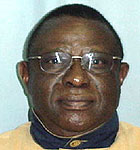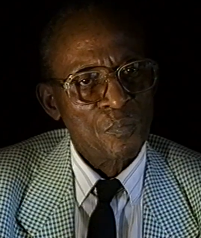Genocide
During testimony at the International Criminal Tribunal for Rwanda (ICTR) investigating the 1994 Rwandan genocide, expert André Guichaoua referred to Butare as the "rebel province." Butare was the only prefecture to be run by a Tutsi, Jean-Baptiste Habyalimana, who actively opposed the genocide. Because it had a large Tutsi minority, prefectural politics were dominated by the Parti Social Démocrate (PSD), rather than the Mouvement Républicain National pour la Démocratie et le développement (MRND), from which the genocidal Interahamwe drew recruits. The Interahamwe in Butare were thus less numerous and less organized than their counterparts in the rest of country. When the country erupted into bloodshed following the death of President Juvenal Habyarimana (no relation to the prefect) on 6 April 1994, Butare was untouched, with the notable exception of the Nyakizu commune. Many Tutsis who fled the violence in other parts of country found haven in Butare.
The calm lasted two weeks. Interim President Théodore Sindikubwabo, himself a native of Butare, appointed a new prefect on 19 April in a ceremony in the prefectural capital. Prefect Habyalimana was shortly thereafter arrested and killed. One of the next to die was former Queen Rosalie Gicanda, described by the ICTR prosecution as "a historical symbol for all Tutsi". Paramilitary units and Interahamwe were then airlifted from Kigali, signaling the start of the killing. It has been suggested that the Hutu government leadership were particularly concerned about Butare because so many of them were natives; besides Sindikubwabo, Prime Minister Jean Kambanda (the first person convicted by the ICTR), General Augustin Ndindiliyimana (head of the Gendarmie), and Pauline Nyiramasuhuko, the minister of women and family affairs were all born in Butare. Despite the fact that the genocide was delayed two weeks, 220,000 would be killed. This is more than 20% of the total and the highest by far of any prefecture.
Human occupation of Rwanda is thought to have begun shortly after the last ice age. By the 11th century, the inhabitants had organized into a number of kingdoms. In the 19th century, Mwami (king) Rwabugiri of the Kingdom of Rwanda conducted a decades-long process of military conquest and administrative consolidation that resulted in the kingdom coming to control most of what is now Rwanda. The colonial powers, Germany and Belgium, allied with the Rwandan court.

The Interahamwe is a Hutu paramilitary organization active in the Democratic Republic of the Congo and Uganda. The Interahamwe was formed around 1990 as the youth wing of the National Republican Movement for Democracy and Development, the then-ruling party of Rwanda, and enjoyed the backing of the Hutu Power government. The Interahamwe, led by Robert Kajuga, were the main perpetrators of the Rwandan genocide, during which an estimated 500,000 to 1,000,000 Tutsi, Twa, and moderate Hutus were killed from April to July 1994, and the term "Interahamwe" was widened to mean any civilian militias or bands killing Tutsi.

The Rwandan genocide, also known as the genocide against the Tutsi, occurred between 7 April and 19 July 1994 during the Rwandan Civil War. During this period of around 100 days, members of the Tutsi minority ethnic group, as well as some moderate Hutu and Twa, were killed by armed Hutu militias. Although the Constitution of Rwanda states that more than 1 million people perished in the genocide, the actual number of fatalities is unclear, and some estimates suggest that the real number killed was likely lower. The most widely accepted scholarly estimates are around 500,000 to 800,000 Tutsi deaths.

Théoneste Bagosora was a Rwandan military officer. He was chiefly known for his key role in the 1994 Rwandan genocide for which he was sentenced to life imprisonment by the International Criminal Tribunal for Rwanda (ICTR). In 2011, the sentence was reduced to 35 years' imprisonment on appeal. He was due to be imprisoned until he was 89. According to René Lemarchand, Bagosora was "the chief organizer of the killings". On 25 September 2021, he died in a prison hospital in Mali, where he was being treated for heart issues.

The assassination of presidents Juvénal Habyarimana and Cyprien Ntaryamira in the evening of April 6, 1994 was the proximate trigger for the Rwandan genocide, which resulted in the murder of approximately 800,000 Tutsi and a smaller number of moderate Hutu. The first few days following the assassinations included a number of key events that shaped the subsequent course of the genocide. These included: the seizing of power by an interim government directed by the hard-line Akazu clique; the liquidation of opposition Hutu politicians; the implementation of plans to carry out a genocide throughout the country; and the murder of United Nations peacekeepers, contributing to the impulse of the international community to refrain from intervention.

Pauline Nyiramasuhuko is a Rwandan politician who was the Minister for Family Welfare and the Advancement of Women. She was convicted of having incited troops and militia to carry out rape during the Rwandan genocide of 1994. She was tried for genocide and incitement to rape as part of the "Butare Group" at the International Criminal Tribunal for Rwanda (ICTR) in Arusha, Tanzania. In June 2011, she was convicted of seven charges and sentenced to life imprisonment. Nyiramasuhuko is the first woman to be convicted of genocide by the ICTR, and the first woman to be convicted of genocidal rape.

Théodore Sindikubwabo was a Rwandan politician who was the interim President of Rwanda during the Rwandan genocide, from 9 April to 19 July 1994. Prior to that, he was President of the Rwandan legislature National Development Council from 1988–1994.
Simon Bikindi was a Rwandan musician and singer who was formerly very popular in Rwanda. His patriotic and nationalist songs were playlist staples on the national radio station Radio Rwanda during the Rwandan Civil War. For his actions during the Rwandan genocide, he was tried and convicted for incitement to genocide by the International Criminal Tribunal for Rwanda (ICTR) in 2008. He died of diabetes at a Beninese hospital in December 2018.

Gitarama was one of the former twelve provinces (intara) of Rwanda and was situated in the centre of the country, to the west of the capital Kigali. Gitarama Prefecture was created in 1959, increasing the number of prefectures of Rwanda from eight to nine. In 2002, it was renamed a province, as were the other prefectures of Rwanda. It had an area of 2,187 square kilometres and a population of some 851,451 prior to its dissolution in January 2006. Gitarama was divided into 8 districts: Muhanga, Kayumbu, Kabagali, Ntenyo, Kamonyi, Ntongwe, Ndiza and Ruyumba; and two towns: Ruhango and Gitarama. Gitarama bordered the provinces Butare, Gikongoro, Kibuye, Gisenyi, Ruhengeri, Kigali-Ngali and Kigali City Tourist attractions included the Kamegeri rocks and the Busaga forest.

The Great Lakes refugee crisis is the common name for the situation beginning with the exodus in April 1994 of over two million Rwandans to neighboring countries of the Great Lakes region of Africa in the aftermath of the Rwandan genocide. Many of the refugees were Hutu fleeing the predominantly Tutsi Rwandan Patriotic Front (RPF), which had gained control of the country at the end of the genocide. However, the humanitarian relief effort was vastly compromised by the presence among the refugees of many of the Interahamwe and government officials who carried out the genocide, who used the refugee camps as bases to launch attacks against the new government led by Paul Kagame. The camps in Zaire became particularly politicized and militarized. The knowledge that humanitarian aid was being diverted to further the aims of the genocidaires led many humanitarian organizations to withdraw their assistance. The conflict escalated until the start of the First Congo War in 1996, when RPF-supported rebels invaded Zaire and sought to repatriate the refugees.
François-Xavier Nzuwonemeye is a former Rwandan soldier, who is chiefly known for his role in the Rwandan genocide.

Major Bernard Ntuyahaga is a Rwandan army officer convicted by a Belgian court for the murders of ten United Nations peacekeepers at the start of the Rwandan Genocide. He was released in 2018 and returned against his will to Rwanda.
These are some of the articles related to Rwanda on the English Wikipedia pages:
Jean-Baptiste Habyalimana was a Rwandan academic and politician who served as the Prefect of Butare and was killed during the Rwandan genocide in 1994. He was the only Tutsi prefect at the time of the genocide, and also the only prefect belonging to the Liberal Party. He had resisted the genocide.
The following lists events that happened during 1994 in the Republic of Rwanda.
Agnès Ntamabyaliro Rutagwera is a Rwandan politician. Though she was of mixed Tutsi-Hutu descent and children of intermarriage were targets during the genocide, Rutagwera has been sentenced for her involvement in the genocide against Tutsi in Rwanda. Notably, she was accused of arranging the murder of Tutsi politician Jean-Baptiste Habyalimana, who resisted the genocide.
Déogratias Nsabimana was a general and Chief of Staff of the Rwandan Armed Forces (FAR), under President Habyarimana from April 1992 until he was killed on 6 April 1994. He also served as Minister of Defense.
Justin Mugenzi is a Rwandan former politician who served as chairman of the Liberal Party and Minister of Commerce during the 1994 Rwandan genocide. He was born in Rukara Commune, Kibungo Province. In 2011 he was convicted, along with Prosper Mugiraneza, of conspiracy to commit genocide and incitement to genocide by the International Criminal Tribunal for Rwanda (ICTR). The convictions were reversed on appeal.
The Bugesera invasion, also known as the Bloody Christmas, was a military attack which was conducted against Rwanda by Inyenzi rebels who aimed to overthrow the government in December 1963. The Inyenzi were a collection of ethnically Tutsi exiles who were affiliated with the Rwandan political party Union Nationale Rwandaise (UNAR), which had supported Rwanda's deposed Tutsi monarchy. The Inyenzi opposed Rwanda's transformation upon independence from Belgium into a state run by the ethnic Hutu majority through the Parti du Mouvement de l'Emancipation Hutu (PARMEHUTU), an anti-Tutsi political party led by President Grégoire Kayibanda. In late 1963, Inyenzi leaders decided to launch an invasion of Rwanda from their bases in neighbouring countries to overthrow Kayibanda. While an attempted assault in November was stopped by the government of Burundi, early in the morning on 21 December 1963, several hundred Inyenzi crossed the Burundian border and captured the Rwandan military in camp in Gako, Bugesera. Bolstered with seized arms and recruited locals, the Iyenzi—numbering between 1,000 and 7,000—marched on the Rwandan capital, Kigali. They were stopped 12 miles south of the city at Kanzenze Bridge along the Nyabarongo River by multiple units of the Garde Nationale Rwandaise (GNR). The GNR routed the rebels with their superior firepower, and in subsequent days repelled further Inyenzi attacks launched from the Republic of the Congo and Uganda.
Joseph Nzirorera was a Rwandan politician and accused génocidaires who was arrested by the International Criminal Tribunal for Rwanda (ICTR) for his role in the Rwandan genocide.







